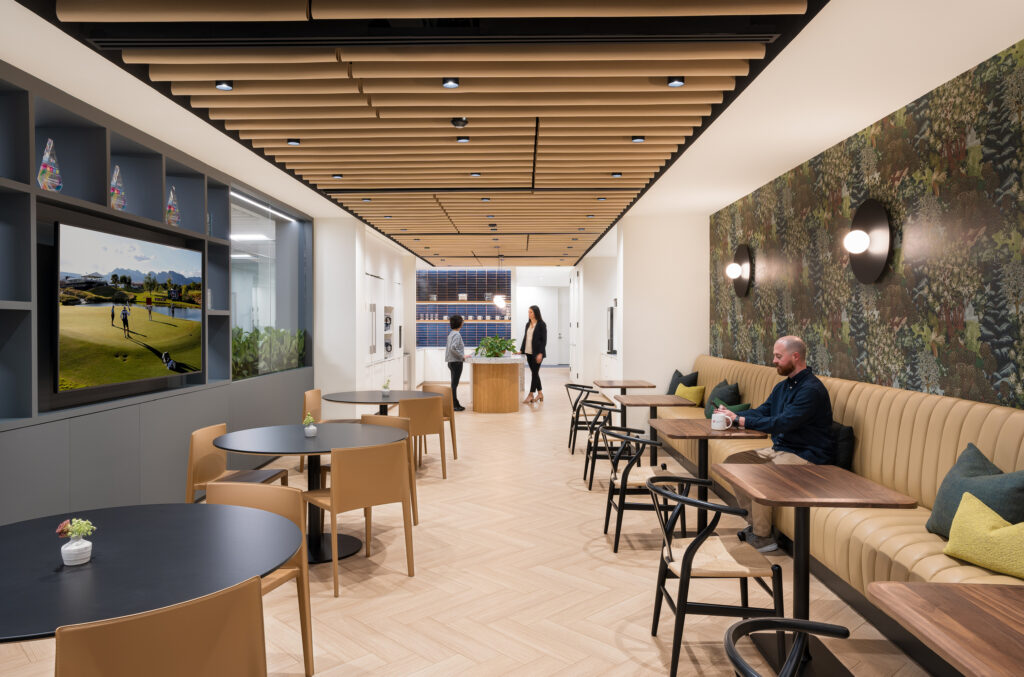
A law firm’s largest expense beyond its people is often its real estate footprint. Strategically investing in a thoughtfully designed space has many benefits, including increasing employee performance and attracting and retaining talent.
In its 20th edition, Gensler’s recent U.S. Legal Workplace Survey asked 250 full-time lawyers at large firms in the United States how they allocate office time across five work modes: working alone, working with others in-person, working with others virtually, learning (professional development and coaching) and socializing. Understanding how lawyers spend time in each mode allows decision makers to make more informed choices regarding the types and sizes of spaces needed in the legal workplace.
From 2013 to February 2020, findings had been relatively consistent; however, in 2022, time spent working alone decreased while learning and socializing increased, highlighting a trend toward collaboration, connection and professional growth. Though solo work remains the most dominant mode, data shows the way lawyers spend their time in the office is steady across roles, which offers predictability when it comes to a firm’s real estate needs.

Though there is an opportunity to standardize space needs based on modes of work, there is an overall disconnect between what the current legal workplace environment is viewed as, which is a business hub — professional and focused — compared to what the ideal would be, which includes choice and variety.
Partner-level survey respondents indicated they spend about one-third of their time in the office, and while they’re in the office, they seek leadership visibility and connection. Conversely, younger associates spend roughly two-thirds of their time in the office for access to technology and focusing on work.
At Akin Gump’s Houston office, open-concept and colorful common break rooms encourage socialization and networking. “I often see young lawyers grab their laptops and sit at our 43rd-floor break area to work on group projects together instead of a traditional conference room,” said Alison Chen, partner in charge of Akin Gump’s Houston office. Common areas that serve multiple purposes enable a firm to utilize its real estate efficiently and flexibly.
Designing workplaces for a mix of uses also helps accommodate the desires of employees at all levels. Respondents at the partner-level want tech-free areas and game rooms, while associates of all ranks seek focus rooms and libraries. Across the board, respondents highly value access to rest and nap spaces.

In our work, we have seen the trend of game areas and rest spaces incorporated in legal workplace design for the last several years — at the proactive request of management.
Employees at Chamberlain Hrdlicka Houston enjoy a dedicated wellness area with reclining furniture, healthy snacks, stress balls, essential oil diffusers and mental health resources, while a sound-masking system absorbs, blocks and covers disruptive noise, providing a more peaceful and productive office.
“When we embarked on our office remodel, we made a deliberate decision to prioritize wellness as a core component of our workplace design,” said Larry A. Campagna, Chamberlain Hrdlicka’s managing partner. “The addition of our dedicated wellness room wasn’t just about creating a nice amenity — it was a strategic investment in our people. Our wellness room has become a recruitment and retention tool for attorneys and professional staff alike.”
Though it is important to pay attention to employee desires, it is critical to understand how implementation will affect performance. An additional component of the U.S. Legal Workplace Survey is the Workplace Performance Index. Gensler measures the WPI as a combination of two factors: effectiveness and experience. Effectiveness refers to how well the space supports work, including function, layout, availability and proximity of individual workspaces, meeting spaces and common areas. Experience pertains to how people feel about space.
Overall, respondents in higher-performing workplaces report that their firms create a climate that continuously fosters innovation (95 percent), compared to lower-performing workplace respondents (62 percent). Higher-performing workplace respondents also indicated that the overall design of their workplace helps attract and retain talent (88 percent) compared to lower-performing workplace respondents (64 percent). With 100 percent of high-performing respondents indicating they have job satisfaction, it’s evident that positive space efficiency and experience correlate to a firm’s ability to attract and retain talent.

The consistency in the survey findings offers more predictability in real estate decision making. In understanding the modes in which employees desire to work, firms can make strategic space accommodations to enhance experience and create a high-performing workplace.
Ken Wiesehuegel is a regional practice area leader of the Workplace, Professional Services group at Gensler

Kimberly Anderson is a seasoned interior designer with over a decade of experience creating high-performance workplaces for law firms and professional services firms across Texas and beyond.

